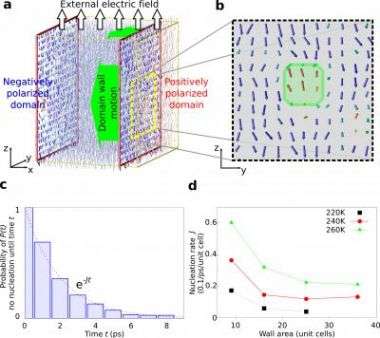Landmark modeling study reveals how ferroelectric computer memory works

A collaboration of University of Pennsylvania chemists and engineers has performed multi-scale modeling of ferroelectric domain walls and provided a new theory of behavior for domain-wall motion, the “sliding wall” that separates ferroelectric domains and makes high-density ferroelectric RAM (FeRAM) possible.
The new theory, supported by a novel modeling study developed specifically for this research, confirms experimental data long at odds with existing theories of domain-wall behavior. Most notable is that, Penn’s simulations reproduced experimental domain growth rates and revealed small, square critical nuclei with a diffuse interface. Researchers also found that small dipoles play a key role in smoothing the transition between up and down regions as the wall moves.
Scaling up, they created a model of how millions of atoms in ferroelectric material respond collectively to a domain wall, extending their theoretical view to the micron and millisecond.
“Now that we know how domain walls in FeRAM move, we can use this understanding to design higher speed and higher density memory materials,” Andrew M. Rappe, professor of chemistry in the Makineni Theoretical Laboratories at Penn, said.
According to the study, the speed at which memory can be saved and erased on this material, called domain-wall velocity, is faster than previously thought. Also, the activation barrier of the material, the energy needed to save or erase memory, is lower than previously thought. Both findings are good news for the future of computer memory using ferroelectric material.
Rappe joined engineers at Penn’s Laboratory for Research on the Structure of Matter to develop the new model of domain-wall behavior. The team started with first principles calculations, the concept that all material properties derive from interactions between electrons and are therefore described by the laws of quantum physics. Later, using Newton’s atomistic molecular dynamics and coarse-grained Monte Carlo simulations — a computational algorithm that simulates the behavior of complex systems with the assistance of random numbers — researchers arrived at the new multi-scale model.
The motion of domain walls is critical to many applications involving ferroelectric materials, such as fast, high-density non-volatile random access memory. In memories of this kind, storing a data bit means increasing the size of one polar region at the expense of another, hence shifting the movement of the domain wall that separates these regions. A better understanding of its behavior may lead to faster, higher-density forms of memory.
Experimental measurements of domain growth rates in PbTiO3 and BaTiO3 have been performed, but the development of new materials has been hampered by a lack of microscopic understanding of how domain walls move. Despite some success in interpreting domain-wall motion in terms of classical nucleation and growth models, these models were formulated without insight from first-principles-based calculations and they portray a large, triangular nucleus with unrealistically large depolarization and nucleation energies, inhibiting practical applications of the materials that save and erase memory.
At Penn, two vital steps in the domain wall motion process were studied: nucleation, when the first part of each plane is flipped, and growth, when the nuclei spread out. Researchers performed finite-size scaling to extract the true nucleation rate from varying system size simulations and extracted the temperature and electric field dependence of the domain wall dynamics.
The study appears online in the journal Nature and in the Oct. 18 print edition.
Source: University of Pennsylvania





















